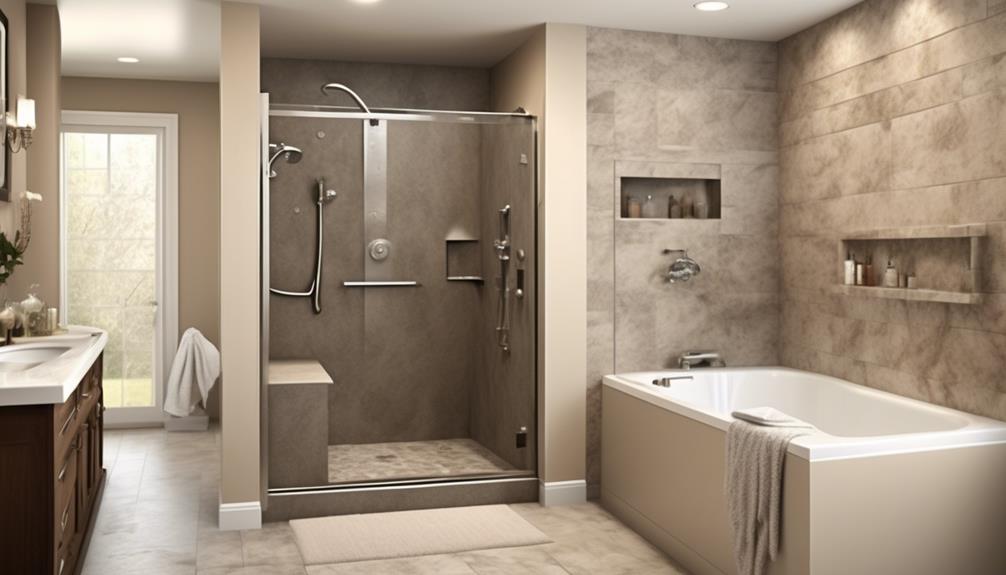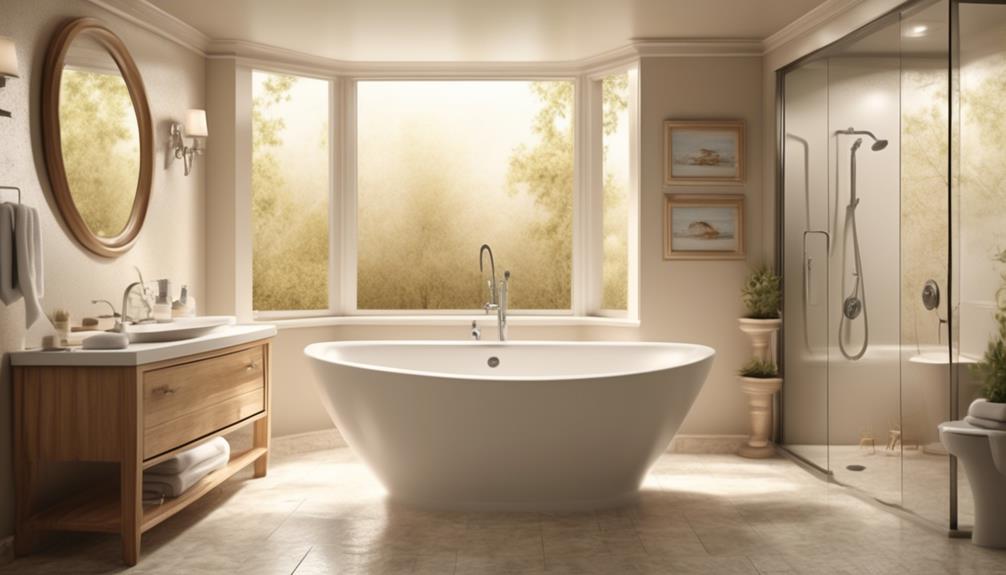Let’s explore a ongoing discussion: Should people with dementia choose a Walk-In Tub or a Walk-In Shower for their bathing requirements?
Picture this: you're faced with the choice of two seemingly beneficial options, but which one truly suits the needs of the individual in question?
Safety, comfort, accessibility – these factors play a crucial role in determining the most suitable bathing solution.
But wait, before you decide, there's an important aspect you might not have thought about yet, and it could make all the difference.
Key Takeaways
- Walk-in showers offer enhanced security with grab bars for dementia patients.
- Immediate access in walk-in showers suits limited patience of dementia patients.
- Understanding individual preferences crucial for dementia patients' comfort during bathing.
- Prioritize comfort, security, and well-being when deciding between tub or shower.
Safety Considerations for Bathing
When caring for dementia patients, ensuring safety during bathing involves installing grab bars and non-slip mats in the bathroom. These safety considerations are crucial to prevent slips and falls, providing a secure environment for individuals with dementia.
Additionally, incorporating warm towels can enhance comfort and promote relaxation during the bathing process. By adapting the bathroom with features like a walk-in tub or walk-in shower, caregivers can further improve safety and convenience for both the individual with dementia and themselves.
Installing grab bars near the bathing area allows for better stability and support when moving in and out of the tub or shower. Non-slip mats inside the bathing area reduce the risk of slipping on wet surfaces, offering an extra layer of protection. By being mindful of these safety measures, caregivers can create a bathing experience that prioritizes the well-being and security of individuals with dementia.
Comfort Features to Prioritize

To enhance the bathing experience for individuals with dementia, it's essential to prioritize comfort features such as padded seating, adjustable showerheads, and temperature controls in both walk-in tubs and showers. These elements not only promote relaxation but also contribute to a sense of safety and well-being during the bathing process. Here are some key comfort features to prioritize:
- Padded Seating: Incorporating padded seating in the bathing area can offer individuals with dementia a comfortable and secure place to sit, reducing the risk of falls and providing a soothing experience.
- Adjustable Showerheads: Adjustable showerheads allow for customization based on the individual's needs and preferences, ensuring a pleasant bathing experience while catering to their comfort level.
- Temperature Controls: Maintaining optimal water temperature is crucial for the comfort and safety of individuals with dementia. Temperature controls help prevent scalding accidents and ensure a soothing bathing environment.
- Proper Lighting: Adequate lighting is essential to reduce confusion or disorientation during bathing. Proper illumination enhances visibility, creating a calming atmosphere and promoting a sense of security.
Accessibility Features Comparison
Comparing the accessibility features of walk-in tubs and walk-in showers reveals significant advantages for individuals with dementia, emphasizing ease of use and safety. Walk-in showers, unlike tubs, are more spacious and easier to maneuver, making them ideal for the elderly with dementia and caregivers.
Additionally, walk-in showers allow for the use of movable shower chairs, providing flexibility during bathing sessions. These showers typically come equipped with grab bars and lower hand-held spray nozzles, enhancing safety measures.
The immediate access to showering without the need to wait for filling or draining in walk-in showers ensures efficient bathing routines, crucial for individuals with dementia. Moreover, walk-in showers are designed to be more adaptable and accessible, even without full ADA compliance, catering to the specific needs of those with dementia.
With these features, walk-in showers stand out as a practical and safe bathing option for individuals dealing with dementia.
Impact on Dementia Patients' Well-being

In considering the well-being of dementia patients, the choice between a walk-in tub and a walk-in shower can profoundly impact their daily bathing experience and overall comfort. When it comes to memory care and the bathing needs of dementia patients, several factors come into play:
- Safety: Walk-in showers with grab bars and non-slip flooring offer enhanced security, reducing the risk of slips and falls for dementia patients.
- Immediate Access: Walk-in showers provide immediate showering without the waiting time needed for walk-in tubs to fill and drain, catering to the sometimes limited patience of dementia patients.
- Accessibility: Walk-in showers are ideal for wheelchair users or those requiring caregiver assistance, ensuring a more comfortable bathing experience for dementia patients.
- Individual Preferences: Understanding the individual preferences and needs of dementia patients is crucial in deciding between a walk-in tub or a walk-in shower, as personal comfort plays a significant role in their well-being.
Considering these aspects can help in creating a bathing environment that promotes the well-being and dignity of dementia patients.
Decision-Making Factors Between Tub and Shower
Considering the unique needs and preferences of individuals with dementia is paramount when deciding between a walk-in tub or walk-in shower for their bathing routine. To make sure the bathing experience is safe and comfortable, it's essential to evaluate key factors. Safety features like grab bars, non-slip flooring, and appropriate water temperature are crucial considerations. Preferences play a significant role as well. Some individuals may feel more at ease in a walk-in tub due to familiarity, while others might prefer the convenience of a walk-in shower.
When deciding between the two options, caregivers should also think about ease of use for both the person with dementia and themselves. A walk-in tub with a door might be easier for some individuals to navigate, while a walk-in shower provides a quick and accessible option. Ultimately, the goal is to prioritize the comfort, security, and overall well-being of the individual with dementia throughout the bathing process.
Frequently Asked Questions
What Are 3 Things to Never Do With Your Loved One With Dementia?
When caring for a loved one with dementia, it's crucial to remember three things:
- Never argue or reason with them.
- Avoid overwhelming them with complex language or choices.
- Never rush or force them to do anything.
These actions can lead to confusion, frustration, agitation, and resistance, damaging the relationship. Instead, prioritize patience, understanding, and gentle support to provide the best care possible for your loved one with dementia.
Is a Walk-In Tub Better Than a Walk in Shower for the Elderly?
We believe that when it comes to bathing the elderly, comfort and safety are top priorities.
Considering the needs of individuals with dementia, a walk-in shower may offer more immediate and efficient bathing experience.
The accessibility features like grab bars and non-slip flooring in showers can enhance safety, providing a secure environment.
Why Won T Dementia Patients Take Showers Anymore?
We understand why dementia patients may refuse showers. Changes in cognition, fear, discomfort, and sensory issues can all play a role. This refusal can be distressing for both the patient and the caregiver.
It's essential to approach bathing with empathy and patience, addressing triggers and adapting the routine to make the experience more comfortable and less intimidating. By understanding their perspective, we can help make showering a more positive experience for dementia patients.
Where Is the Best Place for a Person With Dementia?
When deciding the best place for a person with dementia, it's crucial to consider their comfort and safety. Understanding their needs and preferences is key. Our goal is to create a supportive environment that promotes well-being.
Conclusion
In the end, whether you choose a walk-in tub or a walk-in shower for bathing a person with dementia, remember that both options have their pros and cons. While safety and comfort are top priorities, it's ironic how the decision ultimately comes down to personal preference and individual needs.
Whichever you choose, just know that your loved one's well-being and comfort are what truly matter in the end.








